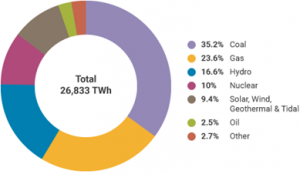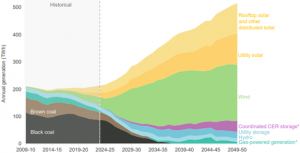Author: Anthony Regan
When discussing the future of energy generation, nuclear power is a subject many have heard of. Given Australia possesses the world’s largest known uranium resources, accounting for nearly one-third of the global total, does this make nuclear a clear contender for energy in Australia?
In 2022, the approximately 440 nuclear power reactors operational in 32 countries provided about 10% of the world’s electricity1. While a significant proportion, nuclear has been declining in its share of global electricity generation since reaching its peak global share back in 1996 [2].

Figure 1: World electricity production by source 2020 (source: International Energy Agency)
During the COP28 environmental conference held at the end of 2023, there was continued backing for nuclear power with a commitment from over 20 countries and more than 120 companies to triple nuclear electricity generation by 2050 [3].
As Australia has a commitment to reach Net Zero by 2050, with an aim to reach emission levels of 43% below 2005 levels by 2030, nuclear has been touted as an option for helping achieve these goals.
The main challenges facing nuclear power in Australia are public acceptability, a legislative ban and economic viability.
While uranium has been mined in Australia since 1954, we have no nuclear energy facilities, other than one nuclear research reactor at Lucas Heights in Sydney which is used for scientific research. The much debated AUKUS nuclear submarines will be powered by onboard nuclear reactors but are not expected to be available until the late 2030’s.
Nuclear power does require the storage or disposal of radioactive waste. Australia does not currently have a central facility for the storage or disposal of radioactive waste which is held at more than 100 locations around Australia [4].
Better understanding of what would be required to increase our nuclear capabilities, centralisation of our management of nuclear waste and watertight regulations will be required in the pursuit of nuclear energy production.
The Australian Radiation Protection and Nuclear Safety Act 1998 and the Environment Protection and Biodiversity Conservation Act 1999 both prohibit the approval, licensing, construction or operation of a nuclear plant in Australia. The amendment of this legislation would be possible, acknowledging that the legislative element of establishing nuclear energy generation would need to be built into the timeline.
While nuclear could still contribute to the net zero target, its impact may not be hugely significant due to the time it would take to properly establish this new industry.
Australia’s current energy production plans to 2050 trend towards an increase in renewable energy as fossil fuels are phased out. Incorporating nuclear into this mix could have benefits in diversifying the energy generation mix post the fossil fuel era.

Figure 2: Generation mix, National Energy Market (TWh, 2009-10 to 2049-50, Step Change), (Source: AEMO) [5]
The push for nuclear power in Australia has called for investment in small modular reactors (SMRs) and the replacement of existing coal fired power plants with nuclear generation infrastructure to help with firming generation. SMRs are a type of modern nuclear reactor small enough to be manufactured in a factory with an estimated capacity of up to 300 megawatt electric (MWe). Their modular assembly allows for scaling to meet electricity demand.
The investment in such technology would be significant and does not currently appear to be economically competitive – a recently cancelled US nuclear project provided indicative costs which informed costings in the 2023-24 GenCost consultation draft.
While increasing the diversity of energy generation in Australia while removing reliance on fossil fuels is a positive goal, to meet the goal of net zero by 2050, nuclear is yet at a disadvantage compared to renewable energy.
References
- World Nuclear Association (2023), World Nuclear Performance Report 2023
- The World Nuclear Industry Status Report 2023 (2023), A Mycle Schneider Consulting Project
- Day, P (2024, January 24), Growing support for nuclear will drive industry forward in 2024, Reuters, Growing support for nuclear will drive industry forward in 2024 | Reuters
- Power, S (2024), Radioactive waste management, Parliament of Australia, BriefingBook45p/RadioactiveWaste
- Draft 2024 Integrated System Plan – For the National Electricity Market (2024, version 1.1), Australian Energy Market Operator Limited